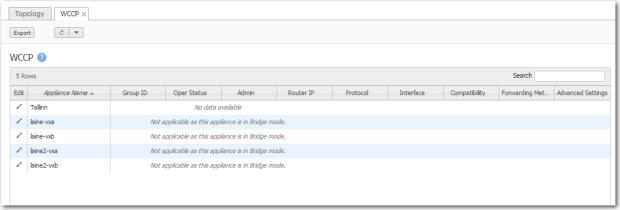|
n
|
For the Service Groups to be active, you must select Enable WCCP. Otherwise, the service groups are configured, but not in service.
|
|
n
|
If the appliance uses auto-optimization, then WCCP redirection must also be applied on the uplinks of the router or L3 switch to the core/WAN.
|
|
n
|
Admin values are up and down. The default is up.
|
|
n
|
Advanced Settings. You can only configure these options directly on the appliance. For more information, and best practices, refer to the Silver Peak Network Deployment Guide.
|
|
n
|
Compatibility Mode. Select the option appropriate for your router. If a WCCP group is peering with a router running Nexus OS, then the appliance must adjust its WCCP protocol packets to be compatible. By default, the appliance is IOS-compatible.
|
|
n
|
Forwarding Method, also known as the Redirect Method. Packet redirection is the process of forwarding packets from the router or L3 switch to the appliance. The router or L3 switch intercepts the packet and forwards it to the appliance for optimization. The two methods of redirecting packets are Generic Route Encapsulation (GRE) and L2 redirection.
|
|
•
|
either allows the appliance and the router to negotiate the best option. You should always select either. During protocol negotiation, if the router offers both GRE and L2 as redirection methods, the appliance will automatically select L2.
|
|
•
|
GRE (Layer 3 Generic Routing Encapsulation) allows packets to reach the appliance even if there are other routers in the path between the forwarding router and the appliance. At high traffic loads, this option may cause high CPU utilization on some Cisco platforms.
|
|
•
|
L2 (Layer-2) redirection takes advantage of internal switching hardware that either partially or fully implements the WCCP traffic interception and redirection functions at Layer 2. Layer-2 redirection requires that the appliance and router be on the same subnet. It is also recommended that the appliance is given a separate subnet to avoid pass-through traffic from being redirected back to the appliance and causing a redirection/Layer-3 loop.
|
|
n
|
Group ID refers to the Service Group ID.
|
|
n
|
Interface. The default value is wan0.
|
|
n
|
|
•
|
INIT. Initializing or down
|
|
•
|
ACTIVE. This indicates that the protocol is established and the router has assigned hash/mask buckets to this appliance.
|
|
•
|
BACKUP. This indicates that the protocol is established but the router has not assigned any hash/mask buckets to this appliance. This may be caused by using a Weight of 0.
|
|
•
|
Designated. This state (in addition to Active/Backup) indicates that the appliance is the designated web-cache for the group. The designator communicates with the router(s) to assign hash/mask assignments. When there is more than one appliance in a group, the appliance with the lowest IP becomes the designator for that group.
|
|
n
|
Protocol. Although many more protocols are supported, generally TCP and UDP are the focus. For troubleshooting, you may consider adding a group for ICMP as well.
|
|
n
|
Router IP is the IP address of the WCCP router. For Layer 2 redirection, use the physical IP address of the interface that is directly connected to the appliance. For Layer 3 redirection, consider using a loopback IP. It is not recommended to use VRRP or HSRP IPs as router IPs.
|
|
•
|
|
•
|
WAN-ingress and LAN-ingress are not applicable if there is only one active appliance.
|
|
•
|
WAN-ingress and LAN-ingress are also not applicable if you are using route-map or subnet sharing to tunnelize.
|
|
•
|
If there is more than one active appliance and you're using TCP-IP auto-optimization:
|
|
•
|
Use LAN-ingress for WCCP groups that are used to redirect outbound traffic.
|
|
•
|
Use WAN-ingress for WCCP groups that are used to redirect inbound traffic.
|
|
•
|
custom provides granular control of the distribution of flows. Contact Silver Peak Technical Support for assistance.
|
|
n
|
Assignment Method determines how redirected packets are distributed between the devices in a Service Group, effectively providing load balancing among the devices. The options are:
|
|
•
|
either, which lets the appliance and router negotiate the best method for assignment. This is preferred. If the router offers both hash and mask methods, then the appliance will select the mask assignment method.
|
|
•
|
hash, for hash table assignment
|
|
•
|
mask, for mask/value sets assignment
|
|
n
|
Force L2 Return is generally not selected. Normally, all Layer-3 redirected traffic that isn't optimized (that is, it's pass-through) is returned back to the WCCP router as GRE (L3 return). Processing returned GRE traffic may create additional CPU overhead on the WCCP router. Force L2 Return may be used to override default behavior and route pass-through traffic back to the appliance's next-hop router, which may or may not be the WCCP router. Use caution, as this may create a Layer 3 loop, if L2 returned traffic gets redirected back to the appliance by the WCCP router.
|
|
n
|
Password. This field is optional.
|
|
n
|
Priority. The lowest priority is 0, and the default value is 128. Only change this setting from the default if an interface has multiple WCCP service groups defined for the same protocol (for example, TCP) and you wish to specify which service group to use.
|
|
n
|
Weight. The default value is 100. You may use this to influence WCCP hash/mask assignments for individual appliances when more than one appliance is in a cluster. For Active/Backup appliance configuration, use a Weight of 0 on the backup appliance.
|

